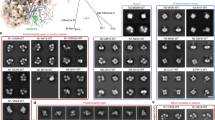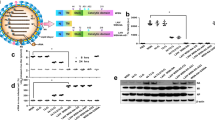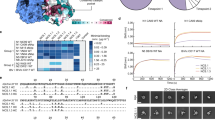Abstract
Influenza A virus neuraminidase can be classified into groups 1 and 2 on the basis of its primary structure. The main structural feature of group 1 neuraminidase is an extra cavity in the active site, the 150-cavity. Here we present the crystal structure of neuraminidase from the 2009 pandemic H1N1 influenza strain. In contrast to other characterized N1 neuraminidases, which are all members of group 1, 2009 H1N1 neuraminidase does not have a 150-cavity.
This is a preview of subscription content, access via your institution
Access options
Subscribe to this journal
Receive 12 print issues and online access
$259.00 per year
only $21.58 per issue
Buy this article
- Purchase on SpringerLink
- Instant access to full article PDF
Prices may be subject to local taxes which are calculated during checkout



Similar content being viewed by others
References
Kobasa, D. et al. Nature 431, 703–707 (2004).
Tumpey, T.M. et al. Proc. Natl. Acad. Sci. USA 101, 3166–3171 (2004).
Novel Swine-Origin Influenza A (H1N1) Virus Investigation Team. N. Engl. J. Med. 360, 2605–2615 (2009).
Wang, T.T. & Palese, P. Cell 137, 983–985 (2009).
Zhang, W. et al. Protein Cell 1, 459–467 (2010).
Xu, R. et al. Science 328, 357–360 (2010).
Yang, H., Carney, P. & Stevens, J. PLoS Curr. Influenza RRN1152 (2010).
Wei, C.J. et al. Sci. Transl. Med. 2, 24ra21 (2010).
Colman, P.M. Protein Sci. 3, 1687–1696 (1994).
Russell, R.J. et al. Nature 443, 45–49 (2006).
von Itzstein, M. Nat. Rev. Drug Discov. 6, 967–974 (2007).
Xu, X., Zhu, X., Dwek, R.A., Stevens, J. & Wilson, I.A. J. Virol. 82, 10493–10501 (2008).
Luo, M. Nature 443, 37–38 (2006).
Mitrasinovic, P.M. Biophys. Chem. 140, 35–38 (2009).
Colman, P.M. Annu. Rev. Biochem. 78, 95–118 (2009).
Varghese, J.N., Laver, W.G. & Colman, P.M. Nature 303, 35–40 (1983).
Sun, Y. et al. Sci. China C Life Sci. 53, 633–642 (2010).
Gao, G.F. & Sun, Y. Sci. China C Life Sci. 53, 151–153 (2010).
Zhang, Y. et al. PLoS ONE 5, e9167 (2010).
Acknowledgements
We acknowledge assistance by the staff at Shanghai Synchrotron Radiation Facility (beamline BL17U). This work is, in part, supported by an intramural grant of the Chinese Academy of Sciences (KSCX2-YW-R-158) and by the Ministry of Science and Technology of China (973 project grants 2010CB534004 and 2011CB504703). G.F.G. is a leading principal investigator of the International Research Group of the National Natural Science Foundation of China (NSFC, grant 81021003). C.J.V. is supported by a CAS Fellowship (2009Y2BS2) and an NSFC grant (31050110126).
Author information
Authors and Affiliations
Contributions
G.F.G. and Q.L. conceived the research; Q.L. and W.Z. carried out the protein expression, purification and crystallization; J.Q. solved the crystal structure; E.F., J.S., H.L., J.W., X.L. and H.J. supplied the reagents. G.F.G., Q.L., J.Q., C.J.V., M.T., Y.S., X.L., J.C., J.H., J.Y. and D.L. carried out the data analysis; G.F.G., J.Q., Q.L., C.J.V., Y.S., and D.L. wrote the manuscript.
Corresponding author
Ethics declarations
Competing interests
The authors declare no competing financial interests.
Supplementary information
Supplementary Text and Figures
Supplementary Figure 1, Supplementary Table 1 and Supplementary Methods (PDF 1069 kb)
Rights and permissions
About this article
Cite this article
Li, Q., Qi, J., Zhang, W. et al. The 2009 pandemic H1N1 neuraminidase N1 lacks the 150-cavity in its active site. Nat Struct Mol Biol 17, 1266–1268 (2010). https://doi.org/10.1038/nsmb.1909
Received:
Accepted:
Published:
Issue date:
DOI: https://doi.org/10.1038/nsmb.1909
This article is cited by
-
Antigenic comparison of the neuraminidases from recent influenza A vaccine viruses and 2019–2020 circulating strains
npj Vaccines (2022)
-
Structural restrictions for influenza neuraminidase activity promote adaptation and diversification
Nature Microbiology (2019)
-
Structure-aided drug development of potential neuraminidase inhibitors against pandemic H1N1 exploring alternate binding mechanism
Molecular Diversity (2019)
-
Implications of protein conformations to modifying novel inhibitor Oseltamivir for 2009 H1N1 influenza A virus by simulation and docking studies
VirusDisease (2018)
-
Topological N-glycosylation and site-specific N-glycan sulfation of influenza proteins in the highly expressed H1N1 candidate vaccines
Scientific Reports (2017)



